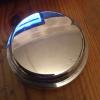I fully understand what you mean. The two races are kept in close contact which makes chipping unlikely. The hammer is most at risk of chipping, but before it was stolen I used one with a hard plastic face. It doesn't need the enormous "g" force of a sharp metal to metal impact to shift the bearing, more the dull thud of a lead shot filled non-bouncing hammer.
I am sure that the bearings are very hard indeed, especially Timkens, but that is accomplished partly by alloying elements rather than making them brittle by simple heat treatment. Otherwise, road shocks might cause the races to crack.
In adverse circumstances it is more important to get the job done than worry too much about things that usually don't happen. But in the course of a business or something like a full restoration the economics are different and I would not dream of doing it that way, I will need a press anyway for my future plans. But that would be of no help to someone who carries tools and basic spares, and has a bearing fail miles from anywhere. That is where the apparently primitive methods can be a real life saver, and why they should be known,
Last time I actually did a Mini that way, a Timken, boxed as Unipart, was about twelve quid and lasted the remaining life of the car. I have never had a premature failure of a bearing I have fitted. Not quite so successful with some other parts...


















